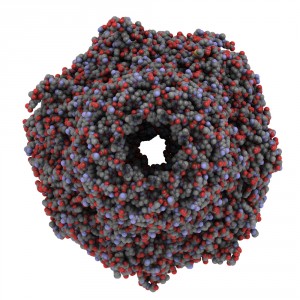 In a new study entitled “Altered ubiquitin causes perturbed calcium homeostasis, hyper activation of calpain, dysregulated differentiation and cataract,” a research team at Tufts University discovered that a change-induced switch from ubiquitin to calpain-mediated degradation pathways is a triggering mechanism for cataracts. The study was published in the journal Proceedings of the National Academy of Sciences.
In a new study entitled “Altered ubiquitin causes perturbed calcium homeostasis, hyper activation of calpain, dysregulated differentiation and cataract,” a research team at Tufts University discovered that a change-induced switch from ubiquitin to calpain-mediated degradation pathways is a triggering mechanism for cataracts. The study was published in the journal Proceedings of the National Academy of Sciences.
Cataracts, an age-related disorder, are characterized by impaired vision due to clouding of the eye’s crystalline lens, a major cause of blindness. More than 18 million people worldwide suffer from cataracts. In the United States alone, at least six million people were submitted to surgery due to cataracts, according to the National Eye Institute and the Centers for Disease Control and Prevention. Common to neurodegenerative diseases such as Alzheimer’s and Parkinson’s disease, cataracts are associated with the toxic aggregation and precipitation of damaged proteins, in this case, in the crystalline lens.
Here, the authors studied the ubiquitin pathway, normally involved in the cleaning process of the cell by removing damaged proteins. They found that a mutation in lysine 6, one of the seven lysine’s of the ubiquitin protein, induces a significant increase in calcium levels (a fourfold increase) in the cells of the eye lens, leading to hyper activation of calpains (calcium-activated intracellular cysteine proteases). This leads to the calpain-mediated cleavage of several key lens proteins, causing lens defects and ultimately cataracts.
These findings show for the first time a connection between ubiquitin proteosome pathways and calpain-mediated degradation pathways. Additionally, the authors unraveled the primary role for ubiquitin lysine 6. This novel insight into cataract onset is crucial to understanding the disease and developing new therapeutics to prevent and delay cataracts, but also other protein aggregate-related diseases as well.
Study lead author Allen Taylor, Ph.D., director of the Laboratory for Nutrition and Vision Research at the Jean Mayer USDA Human Nutrition Research Center on Aging (USDA HNRCA), and a professor at the Friedman School of Nutrition Science and Policy at Tufts University commented in a press release, “We discovered that the ubiquitin pathway and the cal pain pathway communicate with one another. When their conversation goes awry, cells start a vicious cycle in which proteins are improperly degraded. This leads to alterations in proteins and the beginning of the clouding of the lens that signals the onset of cataract. Ubiquitin is found in every cell in plants, animals and people; therefore it’s possible this interaction with calpain is occurring elsewhere in the body. If it is, that would provide the opportunity to learn more about how abnormal proteins may accumulate in other disease states that are similar to cataract, including neurodegenerative diseases such as Alzheimer’s and Parkinson’s.”


